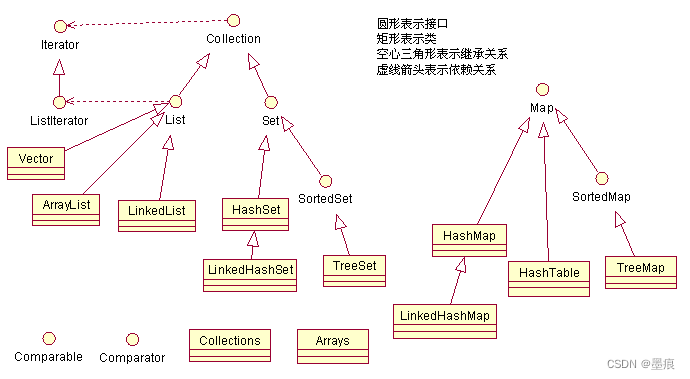集合框架之Map
1.集合框架
2.Map集合
无序、以键值对的形式添加元素,键不能重复,值可以重复,它没有继承Collection接口。
2.1.特点
-
无序
Map map=new HashMap();
map.put("zs", "123");
map.put("ls", "456");
map.put("ww", "789");
System.out.println(map); -
以键值对方式存储数据
Map map=new HashMap();
map.put("zs", "123");
map.put("ls", "456");
map.put("ww", "789"); -
键唯一,值不唯一
Map map=new HashMap();
map.put("zs", "123");
map.put("ls", "456");
map.put("ww", "789");
map.put("zs", "1234");
System.out.println(map); 键相同的情况下,值被覆盖
2.2.遍历方式
-
获取所有的Key
Map map=new HashMap();
map.put("zs", "123");
map.put("ls", "456");
map.put("ww", "789");
//获取Map集合中所有的键
Set keys = map.keySet();
for (String key : keys) {
System.out.println(key);
} -
获取所有的Value
Map map=new HashMap();
map.put("zs", "123");
map.put("ls", "456");
map.put("ww", "789");
//获取Map集合中所有的值
Collection values = map.values();
for (String value : values) {
System.out.println(value);
} -
获取所有的键值对
Map map=new HashMap();
map.put("zs", "123");
map.put("ls", "456");
map.put("ww", "789");
//获取Map集合中所有的键值对
Set> entrySets = map.entrySet();
for (Entry entry : entrySets) {
System.out.println(entry.getKey()+" "+entry.getValue());
} 2.3.HashMap与Hashtable的区别
-
HashMap是Hashtable的轻量级实现(非线程安全的实现),他们都完成了Map接口,主要区别在于HashMap允许空(null)键值(key),由于非线程安全,在只有一个线程访问的情况下,效率要高于Hashtable。
-
HashMap允许将null作为一个entry的key或者value,而Hashtable不允许。
-
HashMap把Hashtable的contains方法去掉了,改成containsvalue和containsKey。因为contains方法容易让人引起误解。
-
Hashtable继承自Dictionary类,而HashMap是Java1.2引进的Map interface的一个实现。
最大的不同是,Hashtable的方法是Synchronize的,而HashMap不是,在多个线程访问Hashtable时,不需要自己为它的方法实现同步,而HashMap 就必须为之提供外同步。 Hashtable和HashMap采用的hash/rehash算法都大概一样,所以性能不会有很大的差异。
就HashMap与HashTable主要从三方面来说。
-
历史原因:Hashtable是基于陈旧的Dictionary类的,HashMap是Java 1.2引进的Map接口的一个实现;
-
同步性:Hashtable是线程安全的,也就是说是同步的,而HashMap是线程序不安全的,不是同步的;
-
值:只有HashMap可以让你将空值作为一个表的条目的key或value
2.4.TreeMap
-
默认升序排序
Map map=new TreeMap();
map.put("2","ls");
map.put("1","ww");
map.put("4","zs");
map.put("3","xl");
map.forEach((k,v)->{
System.out.println(k+"="+v);
}); -
reverseOrder降序排序
Map map=new TreeMap<>(Comparator.reverseOrder());
map.put("2","ls");
map.put("1","ww");
map.put("4","zs");
map.put("3","xl");
map.forEach((k,v)->{
System.out.println(k+"="+v);
}); -
Value值排序
Map map=new TreeMap();
map.put("2","ls");
map.put("1","ww");
map.put("4","zs");
map.put("3","xl");
//按照map中的value属性排序
List> lst=
new ArrayList>(map.entrySet());
Collections.sort(lst, new Comparator>() {
@Override
public int compare(Map.Entry o1, Map.Entry o2) {
return -o1.getValue().toString().compareTo(o2.getValue().toString());
}
});
lst.forEach(s->{
System.out.println(s);
}); 3.其他工具类
-
Collections:工具类,提供一组静态方法操作Collection集合
-
Arrays:工具类,提供了一组静态方法操作数组
